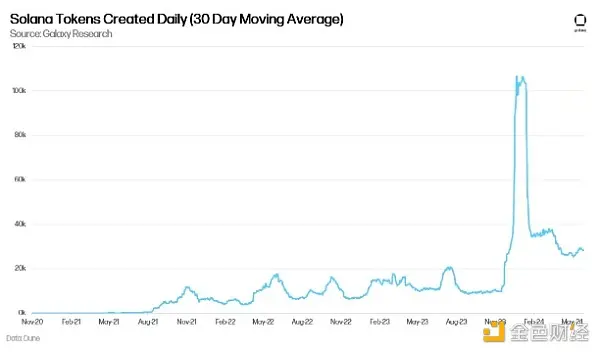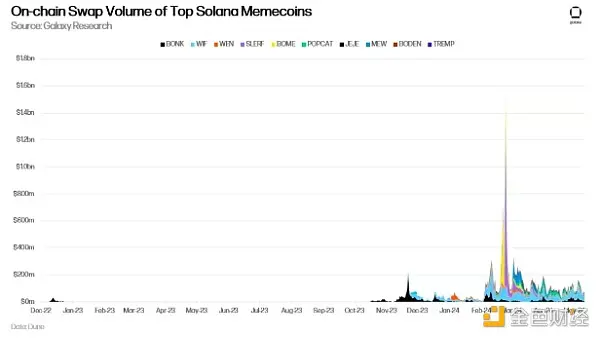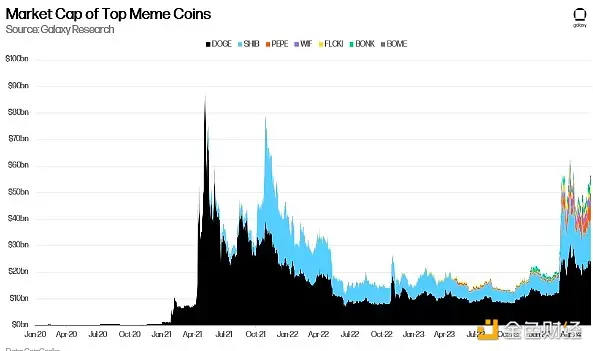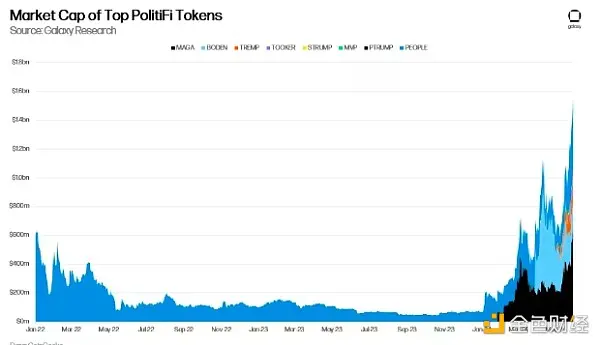Title: "The Evolution of Memes and Their Place on Blockchains"
Author: Zack Pokorny, Galaxy
Translation: Baishui, Golden Finance
Love them or hate them, memes have become the cornerstone of the crypto economy. Not known for technological innovation or breaking the boundaries of blockchain expansion, some skeptics claim that memes have no value at all. Some builders of the blockchain ecosystem even believe that memes have overshadowed their serious work, damaging the overall brand and image of crypto. However, due to their viral nature, memes have surged and accumulated tremendous value in the broader crypto market.
Fundamentally, memes are ideas, symbols, or behaviors that spread within or between subcultures. History shows that memes have existed in human civilization for centuries through different forms and different media. They are likely to continue to exist and be presented on the most widely used communication channels. During the peak of their popularity, memes surged significantly as investors gathered on websites like r/wallstreetbets to express dissatisfaction with the status quo by investing in stocks heavily shorted by Wall Street giants (most notably GameStop). The permissionless nature of blockchain further amplified this phenomenon. While Dogecoin may have been the original meme, the popularity of memes has exploded in recent years. We estimate that the total market value of memes on permissionless blockchains currently exceeds $60 billion. The growth of memes is built on the currency links shared by holders of non-fungible token projects, indicating that communities, cultures, groups, and trends may increasingly rely on monetary tools for cohesion and speculation.
The Evolution of Memes and Their Forms of Expression
While the content of memes and the information they convey have evolved with changes in society, culture, and technology, the digital images we share and mock today are essentially nothing new. They are a continuation of something that has evolved over thousands of years of human evolution. Storytelling is an essential part of human beings, and viral meme images, prose, and concepts have played an important role in the formation and change of human society, whether in organic marketing or intentional propaganda. From cave paintings to Roman graffiti, from virally circulated anonymous pamphlets to newspaper cartoons, widely shared images and concepts have conveyed knowledge, helped overthrow governments, and driven social change in various eras.
While this general sense of memes has always existed, two important components have fundamentally changed throughout history: the media for expressing them and the ways they are disseminated. Oral traditions in ancient societies condensed complex histories into memorable, repeatable stories, which were crucial for passing on knowledge to future generations. Viral images were widely used to convey political messages in ancient Greek and Roman societies, and as the methods of creation and dissemination became increasingly advanced and convenient, the influence of viral images grew. Blockchain represents the next stage of meme evolution, as its technology has become widely standardized, ledgers are permanent and immutable, and accessible globally.
The Evolution of the Canvas for Memes
Since the birth of humanity, the inherent desire to express and share experiences, emotions, and ideas has been the driving force of communication and cultural development. The earliest humans used charcoal and chisels to carve their thoughts and observations on cave walls and stones, creating the first known "memes." These primitive memes demonstrated the basic human need for connection and the sharing of cultural elements.
As civilization prospered and technology advanced, the media for depicting memes continued to evolve. Paint, ink, stone tablets, and paper became new canvases, with beautiful murals appearing in ancient public buildings, repulsive graffiti in Roman amphitheaters, and satirical cartoons in newspapers.
The birth of modern internet memes in 1993 marked the last paradigm shift in the way we express and share ideas. Through email and message boards, the digital domain became the new frontier for meme evolution, allowing individuals to participate and share memes on a larger, more expressive scale.
Today, the emergence of memes places us on the edge of another transformative moment in the history of expression and distribution, thereby changing interpersonal communication. The widespread use of blockchain as the canvas for memes and peer-to-peer (P2P) networks as the distribution channels signifies a new era in human communication and cultural evolution. Just as the printing press in the 15th century fundamentally changed the dissemination of ideas (ultimately memes), and television and the internet in the 20th century changed the dissemination of ideas, blockchain will redefine the way we create, share, and consume memes and information in the 21st century.
The Evolution of Memes' Distribution
In the early stages of human civilization, memes were probably exchanged through hand-to-hand communication, a process that, while not efficient for mass dissemination, was the most advanced means of communication at the time. As humans developed more complex communication tools and technologies, such as writing, printing, and painting, the dissemination of memes became more widespread. Graffiti on building walls and paintings in public places allowed a wider audience to access these cultural elements, even though the spreadability of memes themselves was still limited.
The emergence of newspapers marked a significant milestone in human communication and the dissemination of memes in the form of cartoons and comics. Although the creation of memes in this medium was more restricted, the use of vehicles such as cars, bicycles, and storefronts as channels for dissemination made the spread of memes much easier. These modes of transportation were among the most important advancements at the time, enabling information, ideas, and culture to spread rapidly to a wide audience.
The rise of television and the internet ushered in a new era of meme dissemination, democratizing access to memes and allowing people to view memes from anywhere in the world. The privileges that once determined access to memes were largely eliminated, as anyone with internet access or television broadcasting could participate in and share these cultural elements. With the advancement of these technologies and their applications, the creation of memes became increasingly simple, and the emergence of tools and platforms facilitated the production and dissemination of memes.
Throughout history, memes have entered the most advanced, influential, and widely adopted communication channels in their own way, all of which have had a significant impact on humanity.
The adoption of blockchain as the medium for expressing memes highlights the increasing importance of this technology as a central platform for sharing ideas and experiences in the pure digital age.
Memes on the Blockchain
Memecoins are tokenized descriptions of internet memes or other humorous events or concepts. They are native assets of the blockchain, transferable, usable for blockchain-based applications, and tradable on secondary markets such as DEX. Memecoins are typically represented by their code or a string of letters identifying them, often accompanied by characters or other visual effects associated with them, much like the memes most people are familiar with today. For example, Dogecoin, created in 2013 as a Layer 1 blockchain to satirize Bitcoin, relies on the recent popularity of Shiba Inu photos online. Dogecoin is a fork of Bitcoin, launched before the rise of tokenization, so $DOGE needs its own Layer 1 blockchain to exist. Today, existing Layer 1 blockchains (such as Ethereum, Solana, and even Bitcoin) are capable of hosting and issuing non-native tokens, and their ecosystems are equipped with ready-to-use token contracts, decentralized exchanges, and other tools to facilitate token issuance.
Behind every memecoin is a contract tied to a Layer 1 blockchain or Layer 2 network, specifying the memecoin's name, supply, and other details outlining its digital identity. Only by deploying one of these token contracts can a memecoin be created. In the early days of blockchain, issuing tokens was costly and cumbersome, requiring technical expertise to write or adjust contracts, issue tokens on the blockchain, and create liquidity pools for trading on DEX. Today, many of these difficulties have been abstracted away, with services automatically issuing tokens and creating liquidity pools after users input the details of their memecoin. Recently, Pump.Fun has become a popular venue for issuing memecoins, but there are many existing token contracts that can be easily deployed on various blockchains. The relative ease of issuing memecoins has created a flywheel effect, leading to an unprecedented scale of memecoin creation and speculation.
Gambling as a Distribution Mechanism
Almost by definition, with very few exceptions, meme coins have little to no practical utility. While Dogecoin is used as gas tokens for purchasing block space on the Dogecoin blockchain, today's meme coins are almost entirely valueless native gas tokens. Instead, meme coins are typically blockchain tokens without corresponding gas or application utility, often promoted by creatives, held by communities, or speculated on by traders as a channel for betting on the relative rise or fall of the underlying meme's viral spread. Due to the lack of underlying fundamental utility, meme coins are highly volatile, and their volatility serves as a vehicle to attract users, leading to their broader use and understanding, as well as the blockchains hosting them. The desire for crazy profits and overnight wealth is a motivating factor for many people interested in meme coins. The possibility of increasing financial wealth is the catalyst that initially (and to this day) drives the adoption of meme coins as a canvas for cultural and emotional expression on the blockchain.
Some argue that this is a flaw, indicating that memecoins are temporary or will gradually disappear as people make and lose money. However, as we have pointed out, memes have always existed, and the desire for quick profits has always existed. While memes have been ubiquitous in the internet age, it is only recently that they have become assets that can be monetized and traded. The tokenization of blockchain combines the powerful viral spread of information with human desire for wealth. This combination is new and likely to continue to be popular.
Meme Data
In this section of the report, we will examine the on-chain activity and value driven by memecoins over the past few years.
Solana is the primary blockchain for memecoins in 2024. Solana's low-cost environment reduces the barriers for users to create and trade memecoins, and the fast transaction confirmation speed makes the blockchain experience comparable to loading memes in a web browser. The end of 2023 marked a turning point for memes on-chain. From August to November 2023, Solana added an average of about 9,000 tokens per day, and now adds an average of 28,000 tokens per day, more than three times that number. At its peak, using a 30-day moving average, it added over 100,000 tokens per day. While not all of these tokens belong to memecoins, the large meme culture on Solana allows it to serve as an agent for memecoin creation in the crypto space.

In the past 30 days, the on-chain transaction volume of top Solana memecoins, by market value, has averaged between $91 million and $109 million. The top two Solana memecoins, Bonk and WIF, accounted for 59% of the average transaction volume during this period, by market value.

As the transaction volume increases, the user base continues to expand. The top ten Solana memecoins collectively have over 1.136 million unique holders. Note that this number considers addresses holding multiple memecoins as a single holder. This trend highlights the coverage of memecoins and the speed at which this trend is spreading.

However, memecoins did not start with Solana. $DOGE is one of the earliest and most valuable meme coins in the crypto space, launched in 2013 and reaching a value of $24 billion as of May 29, 2024. $DOGE was launched on its own blockchain, Dogecoin network. In addition to Dogecoin, Ethereum was the original platform for meme coins during the 2020-2022 crypto bull market cycle. Ethereum is the birthplace of iconic memes such as SHIB, and more recently, PEPE and Harry Potter Obama Sonic 10 Inu, playing a significant role in establishing memes on the blockchain. Even though activity on Ethereum has shifted to other networks, it still hosts the second and third largest meme coins, SHIB and PEPE.
As the number of meme coins grows, so does their scale. As of May 29, 2024, the total value of top memecoins is $57 billion, a 3.5x increase from the same period last year and a 4.8x increase from the bear market low. An interesting feature of this chart is that four of the seven memecoins in the chart were created in the last 511 days as of May 29, 2024; two of the seven memecoins were launched within 160 days. This highlights the rapid-changing nature of memecoins and their lack of longevity due to the rapid development of today's human and internet culture.

Over time, people have become increasingly accustomed to using blockchain as a platform for cultural exchange, and the types of memes appearing on-chain have become more specific, from major dog and animal coins to memecoins expressing political beliefs and viewpoints. This shift indicates that blockchain is becoming a more important means of communication, with memes as the primary vehicle. The following chart tracks the total market value of top "PolitiFi" tokens or memecoins depicting political figures and symbols.
It was not until 2024, the year of the 60th quadrennial presidential election in the United States, that these types of memes appeared on the blockchain. Memecoins representing political figures were virtually non-existent in the past, despite their existence over several election cycles. However, some politicians, such as former U.S. President Donald Trump, have attempted NFTs in the past.

The Obscure Utility of Memecoins
While memecoins as assets generally do not offer any specific utility—unlike Layer 1 native assets used for purchasing block space, and with little to no governance or application utility—some have led to significant secondary activity. For example, the dog-themed memecoin $BONK was launched on Solana shortly after the FTX crash at the end of 2022. Due to its close association with Sam Bankman-Fried and FTX, the usage of the Solana blockchain significantly declined. $SOL itself, the native token of the Solana blockchain, has dropped 86% from its all-time high in November 2021, and a further 78% between the FTX crash and early 2023. $BONK was initially intended to reignite interest in Solana and catalyze on-chain activity by airdropping free memecoins to Solana developers, app users, and NFT holders. It has indeed been effective; aside from a significant price increase, $BONK has integrated into the Solana ecosystem with over 129 integrations in DeFi, gaming, NFT, and other types of on-chain applications since its launch. It has become a major sponsor of Solana and non-Solana related social/cultural events, and has developed its own bonk-specific applications, such as Bonk AMM, ownership contracts, and even a gamified fitness app called Moonwalk.
Memecoins can also serve as liquidity flowing through newly designed application pipelines. Decentralized exchanges and DeFi applications that serve memecoins today may become the infrastructure supporting more traditional tokenized markets in the future. Just as MakerDAO is an application that allows users to convert ETH into stablecoins, but is now one of the primary ways for traditional asset issuers to bring U.S. Treasury bonds onto the chain, the explosive growth of memecoins may also lead to the development and evolution of new application primitives, driving future, more enduring blockchain adoption.
Conclusion
In 2024, two major sub-markets have been driving most of the traffic and interest in the cryptocurrency market: Bitcoin (especially considering the launch of spot BTC ETP in the United States) and memecoins. Other important sub-markets (such as NFTs, DeFi, and gaming) continue to grow and develop, but their tokens have mostly underperformed, and the market has not yet embraced them as driving narratives. Newer technical concepts are still the most pressing concerns for people, such as modularity and re-staking, but most of them have not been rolled out. Bitcoin's continued strong performance and increasing institutional adoption continue to be a powerful macro cryptocurrency narrative, but the most powerful native cryptocurrency narrative in today's market is memecoins.
While many consider memecoins to be nihilistic and inherently useless, their existence is built on the foundation of several generations of viral stories, and their activities continue to drive the adoption of blockchain. Their significant role in appearing on-chain is not about how much they should be worth, but about using blockchain as a communication channel to spread them—because they are expected to become a broader channel for societal expression. As blockchain gains more attention as a means of communication and cultural exchange, the fusion of memes with technology places this new medium on par with newspapers, cars, television, and the internet, all of which have had a tremendous impact on humanity and become globally adopted technologies.
免责声明:本文章仅代表作者个人观点,不代表本平台的立场和观点。本文章仅供信息分享,不构成对任何人的任何投资建议。用户与作者之间的任何争议,与本平台无关。如网页中刊载的文章或图片涉及侵权,请提供相关的权利证明和身份证明发送邮件到support@aicoin.com,本平台相关工作人员将会进行核查。




